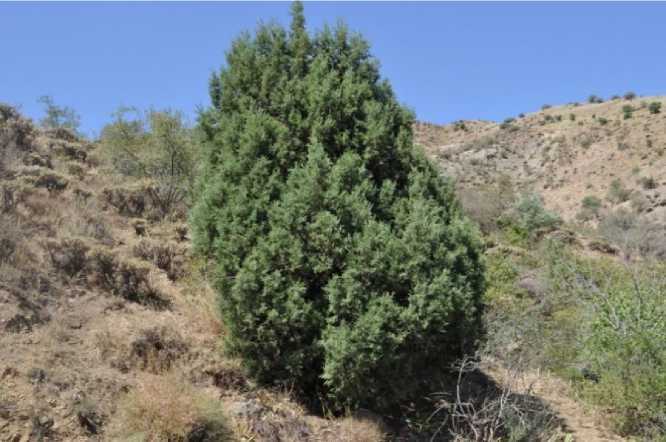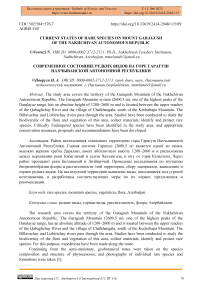Current State of Rare Plant Species on Mount Garagush of the Nakhchivan Autonomous Republic
Автор: Novruzi N.
Журнал: Бюллетень науки и практики @bulletennauki
Рубрика: Естественные науки
Статья в выпуске: 6 т.11, 2025 года.
Бесплатный доступ
The study area covers the territory of the Garagush Mountain of the Nakhchivan Autonomous Republic. The Garagush Mountain system (2600.5 m), one of the highest peaks of the Daralayaz range, has an absolute height of 1200‒2600 m and is located between the upper reaches of the Qabaglichay River and the village of Chalkhangala, south of the Kechaltapa Mountain. The Billavachay and Lizbirtchay rivers pass through the area. Studies have been conducted to study the biodiversity of the flora and vegetation of this area, collect materials, identify and protect rare species. Critically Endangered species have been identified in the study area, and appropriate conservation measures, proposals and recommendations have been developed.
Rare species, mountain species, vegetation, flora, Azerbaijan
Короткий адрес: https://sciup.org/14132783
IDR: 14132783 | УДК: 502/504+576.7 | DOI: 10.33619/2414-2948/115/09
Текст научной статьи Current State of Rare Plant Species on Mount Garagush of the Nakhchivan Autonomous Republic
Бюллетень науки и практики / Bulletin of Science and Practice Т. 11. №6 2025
UDC 502/504+576.7
The research area covers the territory of the Garagush Mountain of the Nakhchivan Autonomous Republic. The Garagush Mountain (2600.5 m), one of the highest peaks of the Daralayaz range, has an absolute altitude of 1200‒2600 m and is located between the upper reaches of the Qabaglichay River and the village of Chalkhangala, south of the Kecheltapa Mountain. The Billavachay and Lizbirtchay rivers pass through the area. Studies have been conducted to study the biodiversity of the flora and vegetation of this area, collect materials, identify and protect rare species. For this purpose, expeditions have been made along the route.
Continuing from the semi-stationary, geobotanical notes were taken on the species composition and structure of phytocenoses, and photographs of individual rare species and formations were taken [1].
Бюллетень науки и практики / Bulletin of Science and Practice Т. 11. №6 2025
Material and Methods.
During the research, classical and modern botanical-floristic, systematic, ecological, areological, phytocenological, plant resources and statistical methods were used.
The conservation status of rare species was given according to the IUCN “Red List” categories, “Red list of The Endemic Plants of the Caucasus. Armenia, Azerbaijan, Georgia, Iran, Russia, and Turkey” [23, 24].
The life forms of plants were given by I.G. Serebryakov and C.R. Raunkier, ecological groups by B.B. Alёkhin, A.R. Shennikov, types, classes and groups of the area by A.A. Grossheim and N.N. Portenier, endemism was classified according to “Flora of Azerbaijan” and separate research works [9‒16].
During the research, the bioecological characteristics and vegetation types of those plant species distributed in the reserves and National Park, plant formations and associations in various zones, rare, endangered species were studied and new ranges of species in the territories were determined.
Result and discussion
22 species belonging to Pinopsida-Conifers were recorded in the territory of the Nakhchivan Autonomous Republic, of which 5 species are found in the wild flora. Of these species, only 3 species belonging to the genus Juniperus L. — Juniper were discovered in the territory of Mount Garagush. These species are as follows:
Phylum: Pinophyta
Classis: Pinopsida
Ordo: Cupressales
Familia: Cupressaceae S.F. Gray
Subfam.: Juniperideae C.Koch
Genus: Juniperus L.
Section.1. Juniperus = Oxycedrus
1(1). Juniperus communis L.
2(2). J. foetidissima Willd.
3(3). J. sabina L.
Here, Juniperus foetidissima Willd. is Critically Endangered R A4acd (Figure).

Figure. Juniperus foetidissima Willd.
Бюллетень науки и практики / Bulletin of Science and Practice Т. 11. №6 2025
As a result of studies conducted in the territory of the Garagush Mountain, the taxonomic spectrum of the class Monocots has been determined.
Desert and semi-desert vegetation is observed in the form of a narrow strip from north to south along the left bank of the Araz River in the form of horizontal zonation in the form of local spots in the direction of the Ordubad region after the Araz River. It covers areas at altitudes of 600‒1000 meters in the plains of Sadarak, Sharur, Boyukduz, Nakhchivan, Gulustan, Yayci, Daste and Ordubad. For the first time, E.M. Gurbanov [6] noted desert vegetation in the Araz-bound areas of the autonomous republic. Some of the semi-desert areas noted by L. I. Prilipko and V. C. Hajiyev were investigated by E.M. Gurbanov. Some typical desert elements were found at the foot of Mount Garagush, especially in the Gender and Sariaghil zones. Examples of these species include Amaranthaceae Juss., (Chenopodiaceae Vent.) — Suaeda dendroides Moq., Halocnemum strobilaceum (Pall.) Bieb. and Seidlitzia florida (Bieb.) Bunge species. However, it is possible to claim that desert vegetation is not fully formed, but rather that desert vegetation is a transition to semi-desert vegetation. In the Demiler, Gendere, Saryaagıl, Ramler and Lizbird valleys of the Garagush mountain, there are locally saline, ephemeral-galliant (colored soil), gammada (gypsum soil) and sandy areas. The latter sandy area is more noticeable in the Lizbird valley. The plants distributed in these areas include Suaeda dendroides (C.A. Mey.) Moq., S. prostrata Pall., S. salsa (L.) Pall., Halocnemum strobilaceum (Pall.) Bieb., Salicornia europaea L., Leontice minor Boiss., Centaurea behen L. [ Microlophus behen (L.) Takht.; Serratula behen (L.) Lam.], Poa bulbosa L., Tulipa biflora Pall. ( T. polychroma Stapf), Fritillaria gibbosa Boiss. [ Rhinopetalum gibbosum (Boiss.) Losinsk. & Vved.], Carthamus oxyacanthus Bieb., C. gypsicola Iljin, Cousinia daralaghezica Takht. and others are found.
Here, mainly short-lived ephemeral and ephemeroid plants, perennial herbs, shrubs, semishrubs, bushes and subshrubs of saline life forms prevail. Cattle feed on these plants most of the year. In some zones (near Boyukduz), favorable desert and semi-desert soils are cleared of salts and included in the crop rotation (Agrophytocenosis), so their area is gradually decreasing.
The Liliaceae Juss. family is distinguished by its decorative plants. The species Fritillaria gibbosa Boiss. [ Rhinopetalum gibbosum (Boiss.) Losinsk. & Vved.], which belongs to the Fritillaria L. genus, is listed in the Red Book of the Nakhchivan Autonomous Republic with the status of VU A2cd. This species was discovered in early spring in the territory of Gendera and Demilar. 3 species belonging to the Tulipa L. genus were discovered in the area, which are also rare plants: Tulipa florenskyi Woronow [VUA3cd; B1b (III, IV) c (II)], T. julia C. Koch [(VUA3cd; B1b (III, IV) c (II)] and T. biflora Pall. [(CR B2ab (II, III, V))] are included in the Red Book of the Nakhchivan Autonomous Republic with the statuses. These species are distributed in the subalpine meadows of the Garagush mountain at 1800‒2000 m above sea level and around the Salakhan caves.
Бюллетень науки и практики / Bulletin of Science and Practice Т. 11. №6 2025
T. biflora Pall. is distributed in the Nakhchivan Autonomous Republic, in the Kur-Araz valley and in the Kur plain. In the foothills and mid-mountain belts of the Nakhchivan Autonomous Republic, it is found on dry grassy, clayey, gravelly and stony slopes at the foothills of the Garagush mountain, Duzdagh, Darydagh, and Arachig mountains. The Red Book of the Nakhchivan Autonomous Republic includes species whose natural condition is at a critical level or whose extinction is likely, as well as those whose future It is listed as Critically Endangered — CR B2ab (II, III, V) as a plant species whose populations are determined to be at risk of severe damage [7].
It is listed in the Red Book of Azerbaijan as Vulnerable — VU; A2c+3c as a species susceptible to extinction [2]. It is a bulbous plant with a thin and bare stem 7‒17 cm high. The bulb is small, reaching a diameter of 1‒1.5 cm, covered with a light-gray, leathery sheath, and soft hairy inside. It has two leaves that join the stem from below. The flower is solitary, rarely 2. The inflorescence is 1.5‒2.5 cm long, the petals are the same, elliptical- oblong, pointed, pale purple or pale greenish-bluish on the outside, white or pale red on the inside, the base of the inner ones is densely ciliate, sometimes bearded. The stamens are shorter than the inflorescence, their stalk is yellow, 2‒2.5 times longer than the stamens. The capsule is 1‒1.5 cm long. It blooms in April, and its seeds ripen in May. It reproduces by seeds and bulbs. It is a geophyte ornamental plant. It is a xeromesophyte, and belongs to the Iranian geographical areal type.
The largest family of the monocot class, Poaceae Barnhart, is represented by 86 species in 53 genera. According to the literature data of the section, Triticum araraticum Jakubz. (CR A1c; B2ab (I, II); C2a (I)) belonging to the genus Triticum L., has the status, but we did not find it in the study area. It is cultivated in the Botanical Garden of the Institute of Bioresources of the Nakhchivan Branch of ANAS.
The species Bromus tzvelevii S.G. Mussajev belonging to the genus Bromus L. also has the status [CR A1c; B2ab (I, II); C2a (I)], but we did not find it in the study area. We can also attribute the same ideas to the species Stipa issaevii S.G. Mussajev & Sadychov (CR B1ac(I)) belonging to the genus Stipa L., which we listed based on the literature data, and Stipa karjaginii S.G. Mussajev & Sadychov [VU A2cd; B1b (II,III) c (II,III)] belonging to the status.
Wheat, a strategic crop, is considered a priority crop for any country in terms of ensuring food security at a time when the world population is constantly increasing, general urbanization processes are intensifying, and global climate changes are occurring. The above-mentioned factors have led to a doubling of the world population's demand for agricultural products in the last 30 years. As a result, wheat production in the world has exceeded 620 million tons in the last five years. These successes have occurred due to the achievements made in the field of wheat breeding. In the last 25 years, wheat production in the world has increased by 100 million tons due to new varieties created through breeding. According to literature data, Triticum araraticum Jakubz. and Triticum durum Desf. species existed in the wild in the study area. However, we did not encounter these species during our research. The list was included based on literature data.
The outstanding florist S.M. Musayev and I.A. Sadigov recorded for science the species Stipa issaevii S.G. Mussajev & Sadychov, S. karjaginii S.G. Mussajev & Sadychov, Bromus tzvelevii S.G. Mussajev in the research area during expeditions.
626 species belonging to 49 families and 351 genera belonging to the class Ikilepeli were recorded in the territory of Garagush Mountain. Of these taxa, the family Papaveraceae Juss. was represented by 12 species belonging to 5 genera. Glaucium Mill. Glaucium elegans Fisch. & C.A. Mey. [LR (a-CD)] belonging to the genus Glaucium was found near the old village of Billava and at the foot of Ardaghi (2230 m).
Бюллетень науки и практики / Bulletin of Science and Practice
The family Cannabaceae Martinov, nom. cons. (Celtidaceae Link) is represented by 2 species belonging to 2 genera in the territory of Garagush Mountain. Celtis caucasica Willd. (Critically Endangered — CR A3c; C2a(I)) belonging to the genus Celtis L. is found in the Khanbulagi and Salakhan forests and thickets on the Garagush Mountain.
Table
|
Familia |
Genus |
Species |
|
Cupressaceae S.F. Grey. |
Juniperus L. |
J. foetidissima (CR A4acd) |
|
Liliaceae Juss. |
Tulipa L. |
T. biflora Pall. (CR B2ab(ii,iii,v)) |
|
Poaceae Barnhart |
Triticum L. Bromus L. Stipa L. |
Triticum araraticum (CR A1c; B2ab(i,ii); C2a(i)) Bromus tzvelevii (CR A1c; B2ab(i,ii); C2a(i)) Stipa issaevii (CR B1ac(i)) |
|
Papaveraceae Juss. |
Glaucium Mill. |
Glaucium elegans (LR [a- CD]) |
|
Cannabaceae |
Celtis L. |
Celtis caucasica (CR A3c; C2a(i) |
The Critically Endangered species studied by me in the Garagush Mountain area are listed in the Table below. These species are included in the Red Books of Azerbaijan and the Nakhchivan Autonomous Republic.


